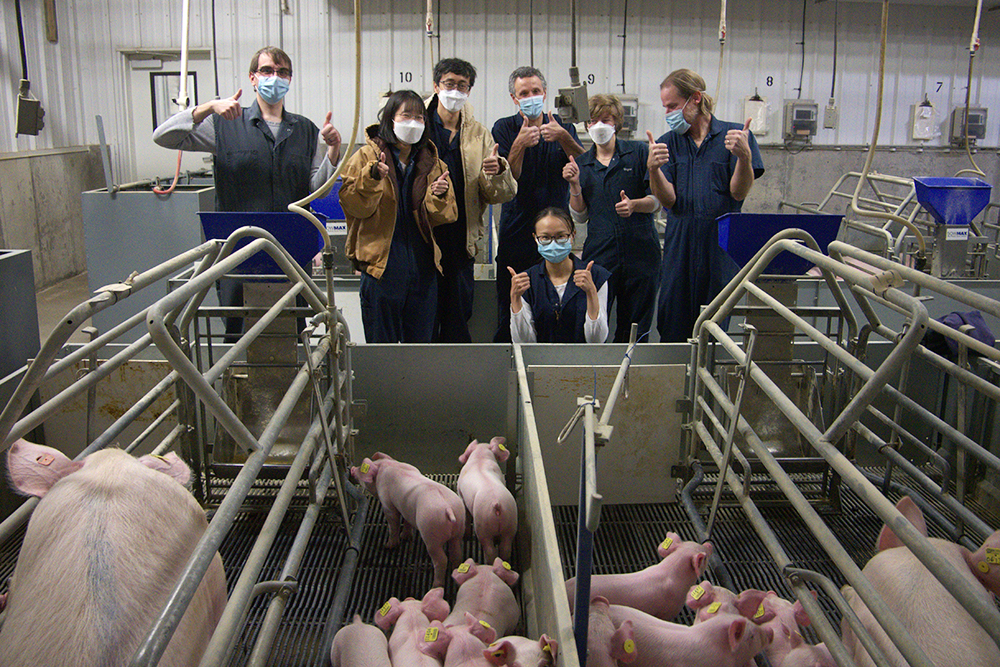Jesse Codling wins Best Presentation award for sensors that help protect these little piggies in their pens

It’s not just the Big Bad Wolf piglets have to fear – they’re more at risk of being trampled in their pens or prevented from nursing by their mother. The mortality rate of piglets is nearly 18%, with much of this loss being caused by sow behavior. This is highly problematic for anyone who raises pigs, and especially for the swine farming industry. To address this issue, ECE PhD student Jesse Codling uses sensors to monitor and classify the vibrations in a pig pen, which can help identify when piglets are in danger and track their feeding habits.
“It’s kind of like in an old movie where a guy puts his ear on the train tracks, and he can tell you when a train is coming,” Codling said. “We’re listening to the floor, and the floor tells us what’s going on.”
It’s kind of like in an old movie where a guy puts his ear on the train tracks, and he can tell you when a train is coming.
ECE PhD student Jesse Codling
Codling installs geophones, which are vibration-detecting sensors, to the underside of the metal pens where the piglets are raised. His team then uses a combination of machine learning-based data models, physics models, and heuristic models to classify behavior in the pen based on the pattern of vibration. For instance, vibration patterns can indicate when a mother sow is getting tired and is in danger of collapsing on top of the litter, or when the piglets are feeding.
“Vibrations are a very information-dense modality,” Codling said. “When the sow stands up, that has a particular frequency distribution. When she lays down or when the piglets are nursing, that’s going to look different. So we look at when the mother’s eating and when the piglets are eating, because that tells us that everybody is doing okay. But if they get sick, their eating behavior changes, and that tells us something is happening.”

The project, affectionately called “The Sh*tty Project” due to the researchers having to crawl through a lot of pig muck to install the sensors, is in collaboration with the U.S. Department of Agriculture. The USDA has relied on other monitoring methods in the past, such as live camera feeds of the pens and wearables on the pigs themselves, but these methods have many limitations.
“If you put a camera in a pig pen, you also need a GPU, so that’s a lot more money,” Codling said. “Then you need to power that GPU, and you need to somehow get all of the data from the camera. Bear in mind that pig farms are not in the middle of a city. They’re in very more remote locations with constant internet problems. We even struggle at times with our vibration stream, which is way smaller than a video feed.”
Then there are wearables, which only work if they remain on the pig, and that is no easy task. Aside from the fact that piglets grow rapidly, which would require a new harness practically every week, pigs are rather destructive to technology in general, something that Codling has experienced personally.
“In one of our first deployments, a sow got loose and immediately ran to the wall and unplugged the central box that was powering all of the sensors,” Codling said. “We lost all of our sensor data for like an hour because of that.”
In general, the sensors are far more protected from the pigs than wearables and cameras, for they are located beneath the pen platform.
Codling presented the research “Sow Posture and Feeding Activity Monitoring in a Farrowing Pen using Ground Vibration,” at the European Conference on Precision Livestock Farming, for which he won a Best Presentation award. In addition to the USDA, the team includes researchers from Stanford University and Carnegie Mellon University.
The team is now exploring a similar approach to detect walking patterns in children with muscular dystrophies, so their caregivers can get a more granular view of the progression of their disease.
Codling earned his Bachelor’s degree in Electrical Engineering from Brigham Young University. He is advised by Prof. Pei Zhang.
 MENU
MENU 
